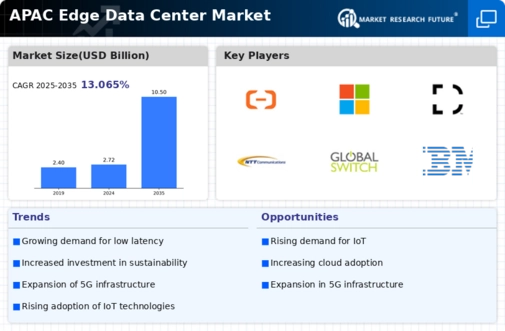China : Unmatched Growth and Infrastructure
Key markets include Beijing, Shanghai, and Shenzhen, where major players like Alibaba Cloud and Tencent dominate the landscape. The competitive environment is characterized by aggressive pricing and innovation, with local firms rapidly expanding their capabilities. The business environment is bolstered by a strong focus on AI and IoT applications, driving demand for edge computing solutions. As industries like e-commerce and fintech flourish, the need for efficient data processing and storage solutions becomes paramount.
India : Emerging Market with High Demand
Key markets include Bengaluru, Hyderabad, and Mumbai, where major players like Amazon Web Services and Microsoft have established a strong presence. The competitive landscape is vibrant, with both The edge data-center market share. The business environment is favorable, with a focus on innovation and technology adoption. Industries such as retail and telecommunications are increasingly relying on edge computing to enhance operational efficiency and customer experience.
Japan : Innovation and Reliability at Core
Tokyo and Osaka are pivotal markets, hosting major players like NTT Communications and IBM. The competitive landscape is marked by a focus on reliability and innovation, with companies investing heavily in R&D. The business environment is characterized by a strong emphasis on quality and customer service. Industries such as automotive and robotics are increasingly leveraging edge data centers to enhance operational efficiency and drive innovation.
South Korea : Digital Transformation Driving Growth
Seoul and Busan are key markets, with major players like Amazon Web Services and Google Cloud establishing a significant presence. The competitive landscape is dynamic, with both local and international firms competing for market share. The business environment is characterized by a strong focus on technology adoption and innovation. Industries such as gaming and e-commerce are increasingly relying on edge data centers to improve user experience and operational efficiency.
Malaysia : Strategic Location for Data Services
Kuala Lumpur and Cyberjaya are key markets, with players like Microsoft and Alibaba Cloud establishing operations. The competitive landscape is evolving, with local firms also entering the market. The business environment is favorable, with a focus on innovation and technology adoption. Industries such as finance and telecommunications are increasingly leveraging edge data centers to enhance service delivery and operational efficiency.
Thailand : Investment Opportunities on the Rise
Bangkok and Chiang Mai are key markets, with major players like AWS and local firms expanding their presence. The competitive landscape is developing, with both The edge data-center market share. The business environment is characterized by a focus on innovation and technology adoption. Industries such as tourism and retail are increasingly relying on edge data centers to enhance customer experience and operational efficiency.
Indonesia : Growth Driven by Digitalization
Jakarta and Bandung are key markets, with players like Alibaba Cloud and local firms establishing a presence. The competitive landscape is dynamic, with both The edge data-center market share. The business environment is characterized by a focus on innovation and technology adoption. Industries such as e-commerce and fintech are increasingly leveraging edge data centers to improve service delivery and operational efficiency.
Rest of APAC : Opportunities Await in Emerging Markets
Countries like Vietnam, Philippines, and Bangladesh are emerging markets with potential for edge data centers. The competitive landscape is still developing, with local players beginning to enter the market. The business environment is characterized by a focus on innovation and technology adoption. Industries such as retail and telecommunications are expected to increasingly rely on edge data centers to enhance operational efficiency and customer experience.

















Leave a Comment